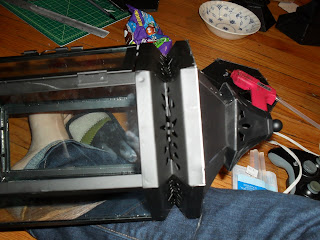In January I was working on another show that needed bones, so I called up the director and asked if I could have them; she was happy to help. After the second show, the bones ended up in one of the crates in my basement where I store prop pieces that I think I am going to keep using.
Several months after that I was working on a show doing puppets (not props) and this conversation occured after one of our tech runs.
Set Designer- I'm a little confused by the line the actor has after the first dance number about it being a perfect transition to talking about the skeletal system.
Director- We were originally thinking of those dancers as being skeletons, but with the masks and the costumes, they ended up being just strangely creepy monsters.
Costume Designer- I think it would be a little late to change the costumes, and other than that line afterwards that doesn't fit, I really like the look of them.
Director- I do too. I don't want to change the costumes, maybe we need to change or cut the line.
Set Designer- What if, when the monsters popped out of the boxes and crates, they had bones that popped out with them. Then, after the dance is over, there will be bones scattered around the stage , and the actor can pick up one of the bones and use the transitional line.
Director- That works for me.
Production Manger- I'll let the Props master (who had a conflict and wasn't at that meeting) know, and see if she can find us some bones.
Me- I have some bones we could use.
-Silent stares-
Me- In a crate in my basement.
-More silent stares-
Me- That sounds weirder now that I say it out loud...
Production Manger- Yeah...
Me- They are props leftover from another show...I bet my neighbors (who also store things in the same basement room) think I'm pretty weird... hadn't really thought of that before...
Production Manger- Moving on...
Sometimes I get so wrapped up in my own world, I forget that the things I do are weird to outsiders. I now keep the bag of bones in a closed box instead of in an open crate to avoid creeping out the other people in my building.































